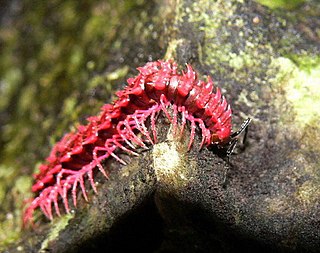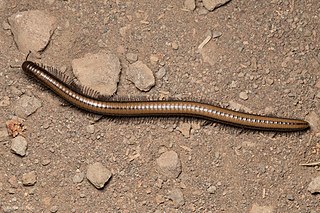
Harpaphe haydeniana, commonly known as the yellow-spotted millipede, almond-scented millipede or cyanide millipede, is a species of polydesmidan ("flat-backed") millipede found in the moist forests along the Pacific coast of North America, from Southeast Alaska to California. The dark coloration with contrasting yellow-tipped keels warn of its ability to exude toxic hydrogen cyanide as a defense. The cyanide secretions are not dangerous to humans, but can cause irritation and pain if it contacts sensitive areas such as the mouth, eyes, or nose.

Desmoxytes, whose species are commonly known as the dragon millipedes, is a genus of millipedes of the family Paradoxosomatidae found in Southeast Asia. The genus was described by Ralph Vary Chamberlin in 1923, and reviewed by Sergei Golovatch and Henrik Enghoff in 1994. At least 18 species are known from to Malaysia, Myanmar, and Thailand. One species, D. planata, has also been observed in Sri Lanka, the Andaman Islands, Seychelles, Java, Great Coco Island, and Fiji; however, this species has expanded its range by being transported through human activity. Several species have only recently been discovered, and some have yet to be officially described.

Xystodesmidae is a family of millipedes in the suborder Leptodesmidea within the order Polydesmida. The family Xystodesmidae was created by the American biologist Orator F. Cook in 1895 and named after the genus Xystodesmus. This family includes more than 390 known species distributed among 62 genera. Many species, however, remain undescribed: for example, it is estimated that the genus Nannaria contains over 200 species, but only 25 were described as of 2006. By 2022, 78 species in Nannaria have been described.

Motyxia is a genus of cyanide-producing millipedes that are endemic to the southern Sierra Nevada, Tehachapi, and Santa Monica mountain ranges of California. Motyxias are blind and produce the poison cyanide, like all members of the Polydesmida. All species have the ability to glow brightly: some of the few known instances of bioluminescence in millipedes.

Paeromopus is a genus of large cylindrical millipedes endemic to the U.S. state of California. All species exceed 10 centimeters in length, and the largest, P. paniculus, reaching 16.5 cm is the longest millipede species in North America. The genus was named by German entomologist Ferdinand Karsch in 1881 and contains four species: three occupying small ranges in the Sierra Nevada mountains and one occupying a large range including the Sierra Nevada and much of Northern California to the Central Coast.

Californiulus yosemitensis is a species of cylindrical millipede in the family Paeromopodidae that is found in western North America: predominantly in the Sierra Nevada of California but also extending into southeastern Oregon and parts of Nevada.

Xystocheir is a genus of millipedes in the family Xystodesmidae. The genus is endemic to California in the United States, where it is distributed in the Coast Ranges and the Sierra Nevada.

Apheloria tigana, known as the yellow-and-black flat millipede, is a large North American flat-backed millipede in the family Xystodesmidae. It is reported to secrete cyanide compounds as a defense. It is recommended that one wash hands after handling this organism as the toxic compounds it secretes are poisonous and can cause extreme irritation if rubbed in the eyes.
Tingupidae is a family of millipedes in the order Chordeumatida. Adult millipedes in this family have 28 or 30 segments. There are 2 genera and 13 described species in Tingupidae.

Selenocheir sinuata is a species of flat-backed millipede in the family Xystodesmidae, endemic to Northern California. The Species was first described by Rowland M. Shelley in 1994 based on samples collected by J. S. Buckett and M. R. Gardner in 1966
Chonaphe is a genus of millipedes belonging to the family Xystodesmidae.

Tubaphe is a genus of millipede in the family Xystodesmidae with a single described species, Tubaphe levii. The genus was erected by Nell B. Causey in 1954.

Chonaphe armata is a species of Xystodesmid millipede found in the Pacific Northwest of North America. The species was first described as Polydesmus armatus by O. Harger in 1872 and was later moved to the new genus Chonaphe, for which it is the type species, by O. F. Cook in 1904.

Selenocheir arcuata is a species of Xystodesmid millipede found in Northern California. The species was first described by Rowland M. Shelley in 1994 based on samples collected by C. Smith, J. Clover, and F. Ennik in 1972.

Sigmocheir furcata is a species of millipede in the family Xystodesmidae. The species in endemic to California and found in the foothills of the Sierra Nevada mountains.

Sigmocheir calaveras is a species of millipede in the family Xystodesmidae. The species in endemic to California and found in the foothills of the Sierra Nevada mountains.

Thrinaphe is a genus of millipede in the family Xystodesmidae with a single described species. The genus was erected by Rowland M. Shelley in 1993 based on samples collected by Dr. Shelley in 1991 as well as museum type specimens collected by K. Goeden in 1968. The genus is found in the Cascade mountains on the Washington/Oregon border as well as down into the Willamette Valley.

Orophe is a genus of Xystodesmid millipede found in the Rocky Mountains of northern Idaho and western Montana.
Orophe cabinetus is a species of millipede in the family Xystodesmidae, which is found in the Rocky Mountains of western Montana. It is the type species of the genus Orophe and was described in 1951 by Ralph V. Chamberlin.

Orophe unicus is a species of millipede in the family Xystodesmidae, which is found in the Rocky Mountains of northern Idaho. The species was originally described as Chipus unicus by H.F. Loomis in 1953 and was later transferred to Orophe by R.L. Hoffman in 1964. Hoffman also suggested that the differences in the gonopods of O. unicus and O. cabinetus were minor and so the relationship between the two may be "subspecific". Loomis and Schmidt later synonymized O. unicus under O. cabinetus based on the subtle nature of this feature. In 1993, Rowland Shelley reexamined the type specimens and based on the differences in the gonopods as well as the allopatric nature of the two populations, reinstated O. unicus as a valid species.
















